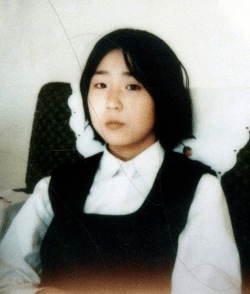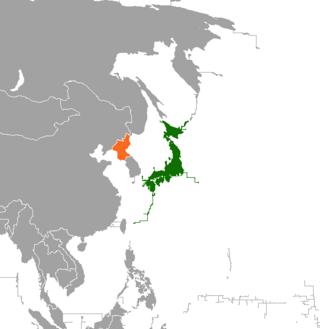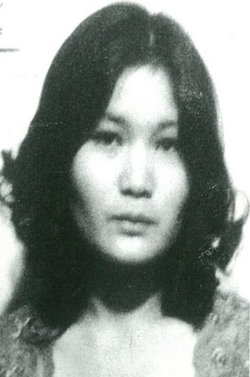
Korean Air Flight 858 was a scheduled international passenger flight between Baghdad, Iraq, and Seoul, South Korea. On 29 November 1987, the aircraft flying that route exploded in mid-air upon the detonation of a bomb planted inside an overhead storage bin in the airplane's passenger cabin by two North Korean agents.

Abductions of Japanese citizens from Japan by agents of the North Korean government took place during a period of six years from 1977 to 1983. Although only 17 Japanese are officially recognized by the Japanese government as having been abducted, there may have been hundreds of others. The North Korean government has officially admitted to abducting 13 Japanese citizens.
The human rights record of North Korea is often considered to be the worst in the world and has been globally condemned, with the United Nations, the European Union and groups such as Human Rights Watch all critical of it. Most international human rights organizations consider North Korea to have no contemporary parallel with respect to violations of liberty.

Megumi Yokota is a Japanese citizen who was abducted by a North Korean agent in 1977 when she was a thirteen-year-old junior high school student. She was one of at least seventeen Japanese citizens kidnapped by North Korea in the late 1970s and early 1980s. The North Korean government has admitted to kidnapping Yokota, but has said that she died in captivity. Yokota's parents and others in Japan have publicly expressed the belief that she is still alive in North Korea and have waged a public campaign seeking her return to Japan.

Shin Sang-ok was a South Korean filmmaker with more than 100 producer and 70 director credits to his name. His best-known films were made in the 1950s and 60s, many of them collaborations with his wife Choi Eun-hee, when he was known as "The Prince of South Korean Cinema". He received posthumously the Gold Crown Cultural Medal, the country's top honor for an artist.

Choi Eun-hee was a South Korean actress, who was one of the country's most popular stars of the 1960s and 1970s. In 1978, Choi and her then ex-husband, movie director Shin Sang-ok, were abducted to North Korea, where they were forced to make films until they sought asylum at the U.S. embassy in Vienna in 1986. They returned to South Korea in 1999 after spending a decade in the United States.

Kim Hyon-hui, also known as Okhwa, is a former North Korean agent, responsible for the Korean Air Flight 858 bombing in 1987, which killed 115 people. She was arrested in Bahrain following the bombing and extradited to South Korea. There she was sentenced to death but later pardoned.

The Japan–North Korea Pyongyang Declaration was signed in 2002, and was the result of a systematic Japan–North Korea summit meeting. The aim of the declaration was to provide low-interest long term loans to North Korea as well as economic assistance, including humanitarian aid, in accordance with the moratorium of nuclear missile development which has been in place since 1999. The Japanese government hoped to learn the fate of Japanese citizens by North Korea which, prior to the declaration, was unacknowledged.

Yaeko Taguchi is a Japanese citizen, one of several kidnapped by North Korea in the late 1970s and early 1980s.
Tens of thousands of South Korean soldiers were captured by North Korean and Chinese forces during the Korean War (1950–1953) but were not returned during the prisoner exchanges under the 1953 Korean Armistice Agreement. Most are presumed dead, but the South Korean government estimated in 2007 that some 560 South Korean prisoners of war (POWs) still survived in North Korea. The issue of unaccounted South Korean POWs from the Korean War has been in dispute since the 1953 armistice. North Korea continues to deny that it holds these South Korean POWs. Interest in the issue has been renewed since 1994, when Cho Chang-ho, a former South Korean soldier presumed to have been killed in the war, escaped from North Korea. As of 2008, 79 former South Korean soldiers had escaped from North Korea.

Mayumi (Korean: 마유미) also known as Mayumi: Virgin Terrorist is a 1990 South Korean film directed by Shin Sang-ok based on the bombing of Korean Air Flight 858. The film was selected as the South Korean entry for the Best Foreign Language Film at the 63rd Academy Awards, but it was not accepted as a nominee.

Japan–North Korea relations refers to international relations between Japan and North Korea. Relations between Japan and North Korea have never been formally established, but there have been diplomatic talks between the two governments to discuss the issue of kidnapped Japanese citizens and North Korea's nuclear program. Relations between the two countries are severely strained and marked by tension and hostility. According to a 2014 BBC World Service poll, 91% of Japanese people view North Korea's influence negatively, with just 1% expressing a positive view; the most negative perception of North Korea in the world.
Kaoru Hasuike is a Japanese citizen who was abducted by North Korean spies along with his girlfriend Yukiko Okudo. They were abducted from their hometown of Kashiwazaki in Niigata prefecture on July 19, 1978. Hasuike was a law student at the time. During their captivity, in May 1980, Hasuike and Okudo were married. They had two children: a daughter, Shigeyo, and a son, Katsuya. On October 15, 2002, the North Korean government allowed Hasuike, Okudo and other victims to leave North Korea to visit Japan. Once there, Hasuike and Okudo decided to remain in Japan and to plead for the release of their children, which was eventually allowed in 2004.
The abduction of Shin Sang-ok and Choi Eun-hee occurred in North Korea between 1978 and 1986. Shin Sang-ok was a famous South Korean film director who had been married to actress Choi Eun-hee. Together, they established Shin Film and made many films through the 1960s which garnered recognition for South Korea at various film festivals. In 1978, Choi was abducted in Hong Kong and taken to North Korea to the country's future supreme leader Kim Jong Il. The abduction of Shin followed six months later.

The Report of the Commission of Inquiry on Human Rights in the Democratic People's Republic of Korea is the landmark document resulting from the investigations on human rights in North Korea commissioned by the United Nations Human Rights Council in 2013 and concluded in 2014.
Choe Ik-gyu, also known under the pseudonym Choe Sang-gun, is a North Korean film director, propagandist, and politician.

An Emissary of No Return is a 1984 North Korean historical drama film directed by Shin Sang-ok and Choi Eun-hee. It was the first of four films Shin and Choi made during their abduction to North Korea under the orders of Kim Jong Il. Adapted from Bloody Conference(혈분만국회 ), a play allegedly written by Kim Il Sung during his guerrilla years, the film retells the dramatized story of the Hague Secret Emissary Affair. The affair ensued when the Korean emperor king Gojong sent three unauthorized emissaries to the talks of the Hague Convention of 1907.

Love, Love, My Love is a 1985 North Korean musical film in the genre of romantic melodrama. The film was directed by Shin Sang-ok while he and his wife Choi Eun-hee were abductees in North Korea. The film was produced by Shin's North Korean company Shin Films.
The Tale of Shim Chong is a 1985 North Korean musical film directed by Shin Sang-ok.

The Database Center for North Korean Human Rights is a nonprofit, non-governmental organization, headquartered in Seoul, South Korea, that conducts data collection, analysis, and monitoring of human rights violations experienced in the Democratic People’s Republic of Korea. NKDB not only offers resettlement support, psychological counseling, and educational opportunities, but also advocates for human rights advancement and transitional justice of past human rights violations in the DPRK.













